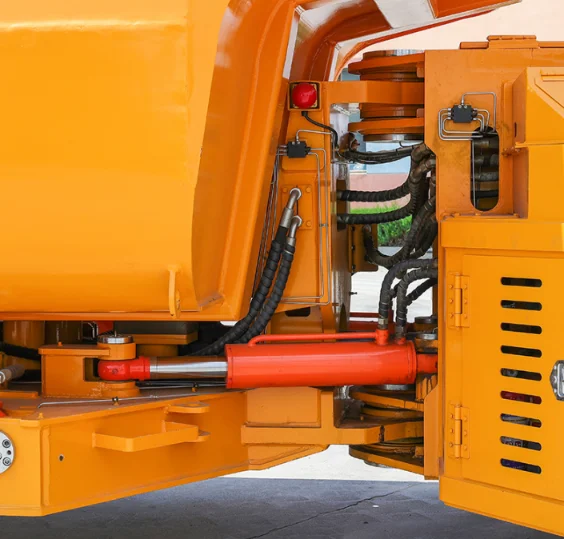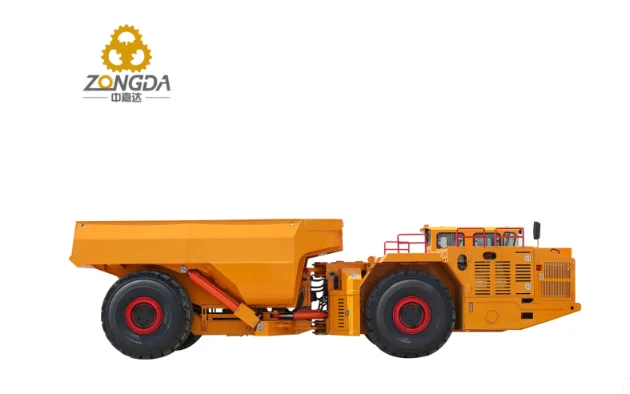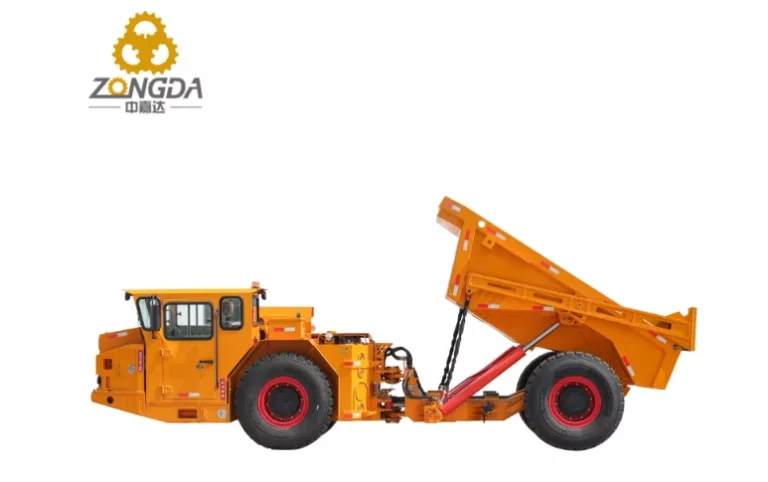
Fuel per ton is the metric that pays the bills. In hard-rock headings, short hauls, grades that bite, tight geometry, and hot air all push that number up. A smart mining vehicle brings it back down by matching power delivery, cooling behavior, traction, and airflow timing to the way your crew actually runs cycles. Tweak the few moments when fuel spikes, and you move more rock on the same liters without slowing shifts.
Why Does Fuel per Ton Beat Every Other KPI?
Highways reward steady speed; mines don’t. Underground work swings between brief pulls, micro-stops, and quick dumps. Generic mileage hides where burn flares. Fuel per ton ties consumption to payload and time, so you see exactly which parts of the loop leak money.
Where Do Losses Show Up First?
Three early tells: light loads that waste a trip, steering corrections in narrow corners, and hot intake air near ramps. Fix those and the curve bends fast.
How Do Duty Cycles Create Burn Spikes?
A typical pattern: three short pulls on a grade, a hold near a crosscut, then a dump. If controls and cooling stay flat across that rhythm, fuel peaks at the wrong seconds and stays there.
What Changes Trim Peaks Without Slowing Work?
Pre-select the gear before the ramp, set a short hold timer where queues form, and time airflow to the pull window. That keeps torque clean and intake temperature down when combustion is most sensitive.
Why Does Payload Utilization Move the Needle So Much?
Under-payload wastes distance. Chronic overload forces rich pulls and heats coolant. The winning approach is a narrow payload band matched to your heading and dump plan, not a brochure maximum.
How Tight Should the Band Be?
Pick a target window and log every face fill. If under-fills rise late in the shift, adjust muck presentation or shovel angle rather than blaming the seat. A small tune here usually pays back in a day.
How Do Route Geometry and Turning Radius Cut Burn?
Every shunt adds seconds and heat. In tight tunnels, turning radius and sight lines often save more fuel than a more aggressive fan map.
Which Layout Tweaks Pay Back Fast?
Convert two-way trouble spots into one-way loops where possible. Paint turn marks that match wheelbase. Place pull-off bays ahead of ramps so resets happen in cooler air, not on the steepest point.
How Does Airflow Planning Lower Fuel Use?
Cooler, cleaner intake raises air density and shortens fan time. The goal is not more air all day, it is enough air exactly when torque rises. For fundamentals and quick onboarding, keep a clear path to underground ventilation resources where new team members can find them fast.
How Do You Time Airflow to the Work, Not the Clock?
If your truck hits three brief hauls each cycle, bump flow a minute before the first pull and let it taper after the last. That narrow window drops intake temperature during the climb and trims burn per ton in the same moments.
Which Small Fixes Multiply the Effect?
Seal door gaps, patch duct leaks along haul routes, and keep return paths clear of parked units. Each degree shaved off intake temperature stacks with smarter shift points.
Which Smart Vehicle Settings Matter Most for Fuel per Ton?
Modern controls let you set behavior for your loop, not a lab run.
Powertrain, Cooling, and Traction That Count
Use upshift points that meet the ramp, not a flat floor. Choose a fan curve that meets limits without sitting at maximum. Keep tires in spec for your surface so spin stays low and pulls stay clean. If slip events spike on one incline, the ramp surface needs work more than the operator does.
How Does Telemetry Turn into Real Savings?
Data only helps if it triggers moves crews actually take. Keep the signal set short and tie each alert to a single action.
Four Signals Worth Watching
Fuel per cycle, intake temperature rise, filter ΔP, and a simple grade fuel delta. Together they tell you whether the truck is breathing right, loaded right, and pulling right.
What Should the Alert Play Say?
For underground ventilation, “Caution” means cool and clear. “Action” means pause the cycle and call for air. Short rules stick; long checklists don’t.
Can Airflow Planning Really Lift Underground Mining Machinery Performance?
Yes. Align air boosts with duty cycles, then watch fuel per ton and cycles per shift over two weeks. If both improve, keep the changes and publish the play internally. The result shows up as a visible gain in underground mining machinery performance, not just nicer graphs.
How Do You Prove the Gain in Live Work?
If your truck runs three short hauls per loop, increase flow just before each pull rather than running high all day. The difference appears within hours: fewer heat alarms, cleaner throttle response, and steadier fuel per cycle.
What Improves Underground Mining Truck Air Quality at the Face?
Fresh air to the cut and clean returns back. That pairing holds torque and cuts smoke complaints without major rebuilds.
Face-Focused Actions That Stick
Seal joints, angle an auxiliary fan across the operator zone, and keep parking out of the return path. Those simple practices support safer conditions and steadier combustion near the face. If needed, route readers to general guidance that lifts underground mining truck air quality at the face—not just on paper.
Will a Compact Truck Lower Heat and Fuel in Confined Drives?
Often. Big engines dump heat faster than narrow headings can clear it. A compact unit shortens exposure time, reduces steering corrections per loop, and clears haze faster between passes.
Where Does a Smaller Truck Fit Best?
Short wheelbase, tight turning radius, lighter heat load. If haze lingers after passes, trial a compact hauler for two weeks and compare intake ΔT, DPM readings, filter life, and cycles per shift. For a reference profile in this niche, see the ZDT210 Underground Mining Truck.

How Do You Calculate Fuel per Ton?
Fuel per ton = Total Fuel Burned (L) ÷ Total Payload Moved (t) over a defined window.
What Does a Worked Example Look Like?
- Window: one 8-hour shift
- Cycles completed: 120
- Average payload per cycle: 16 t
- Total payload moved: 1,920 t
- Fuel used from telemetry/dispense: 2,700 L
- Fuel per ton: 2,700 ÷ 1,920 = 1.41 L/t
After two small changes—timed airflow before pulls and pre-grade gear selection—
- Cycles: 126
- Same payload per cycle: 16 t → 2,016 t
- Fuel used: 2,780 L
- Fuel per ton: 2,780 ÷ 2,016 = 1.38 L/t
You burned a bit more fuel overall because you moved more rock, yet fuel per ton fell ~2% and cycles per shift rose 5%. That is the curve you want.
What Changes Show Up in Route Geometry Before and After?
Think in pictures: less steering, fewer resets, cleaner passes.
How Would You Caption the Before and After?
- Before: two-way corner near a ramp with a blind bend; three-point turns common, idle stack at the crosscut, intake ΔT spikes on every pull.
- After: one-way loop with painted turn marks matched to wheelbase; a pull-off bay before the ramp; fewer corrections, lower intake ΔT, smoother fuel-per-cycle curve.
Introduction to ZONGDA
QINGDAO ZONGDA MACHINERY CO., LTD serves underground metal-ore headings with compact underground mining trucks and loaders sized for narrow drives. Designs focus on stable cooling margins, clean intake paths, and fast service access, so crews hold torque on grades while air stays clean at the face. The build philosophy is practical: use geometry and timing to lower fuel per ton, lift cycles per shift, and avoid heat-driven derates in hard-rock work. If headings struggle with heat spikes or maneuver losses, a compact chassis paired with timed airflow often moves the needle faster than a larger engine.
FAQ
Q1: Which KPI proves fuel per ton is falling?
A: Fuel per cycle paired with cycles per shift. If both improve, you are moving more rock per liter, not just idling less.
Q2: How fast do airflow tweaks show up in fuel data?
A: Same shift on busy headings. Time a boost before pulls and watch intake ΔT drop during the climb.
Q3: What is the quickest maintenance win?
A: Cooling-pack cleaning tied to dust load and a firm filter ΔP threshold. Both lower fan time and smooth throttle.
Q4: Do compact trucks always save fuel?
A: Not always, but in tight tunnels they cut steering corrections and heat, which lowers burn per ton and clears air faster.
Q5: How many alerts should operators track?
A: Four. Fuel per cycle, intake ΔT, filter ΔP, and a simple grade fuel delta—each tied to one clear action.



